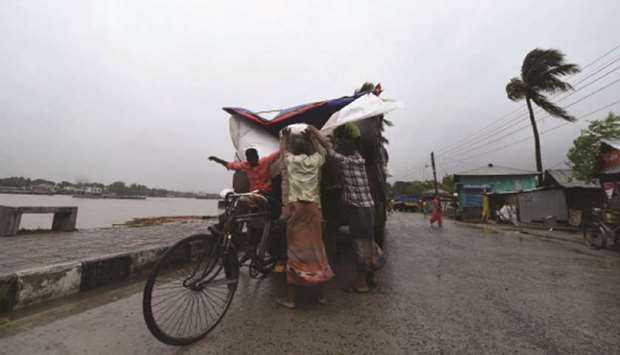Millions of people battened down yesterday as the strongest cyclone in decades slammed into Bangladesh, killing at least three and leaving a trail of devastation.
Authorities scrambled to evacuate more than 2mn people from low-lying areas, but the task was complicated by the need to prevent the spread of coronavirus.
As it made landfall, Cyclone Amphan tore through coastal villages, flattening mud houses, blowing off roofs, uprooting trees and laying waste to crop fields.
Bangladeshi officials confirmed three deaths including a five-year-old boy and a 75-year-old man, both hit by falling trees, and a cyclone emergency
volunteer who drowned.
Amphan is the first “super cyclone” to form over the Bay of Bengal since 1999, and packed winds gusting up to 185km (115) per hour.
Forecasters also warned there could be storm surges of several metres.
Such walls of water can cascade several kilometres inland and are often the main killers in major weather systems.
Bangladesh’s low-lying coast, home to 30mn people, is regularly battered by cyclones that have claimed the lives of hundreds of thousands of people in recent decades.
While the frequency and intensity of storms have increased – blamed partly on climate change – casualties have fallen thanks to faster evacuations, better technology and more shelters.
But Bangladesh authorities still fear Amphan will be the most powerful storm front since Cyclone Sidr killed about 3,500 people and caused billions of dollars in damage in 2007.
Enamur Rahman, Bangladesh’s junior minister for disaster management, said that 2.4mn people and over half a million livestock had been brought to shelter.
Because of coronavirus, authorities were using extra shelter space to reduce crowding, while also making face masks compulsory and setting aside isolation rooms.
Infection numbers are still soaring.
Sulata Munda, a tribal villager, said she and fellow villagers had decided not to go to a shelter.
“We fear the cyclone, but we also fear the coronavirus,” the mother of four said.
At a school in the coastal town of Dacope where more than 200 locals were sheltered, masks were in short supply.
“The room is already packed and maintaining social distancing is impossible,” said Rumki Khatun, 25, clutching her baby.
Nearby, hundreds of people were trying to reinforce a creaky river dam. Local official Sheikh Abdul Kader said that if it broke, up to 50,000 people would be marooned. “The dam must be protected,” he said.
Although outside Amphan’s predicted path, there are fears for the almost 1mn Rohingya refugees in southeastern Bangladesh – most living in flimsy, makeshift shacks.
The first coronavirus cases were reported in the teeming camps last week, and by Tuesday there were six confirmed
infections.
The UN said food, tarpaulins and water purification tablets were stockpiled, while authorities said the refugees would be moved to sturdier buildings if needed.
“We are fully prepared,” said Mahbub Alam Talukder, Bangladesh’s refugee
commissioner.

Workers unload goods from a truck ahead of the expected landfall of Cyclone Amphan, in Khulna, 271km from Dhaka, yesterday.


